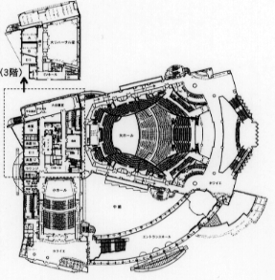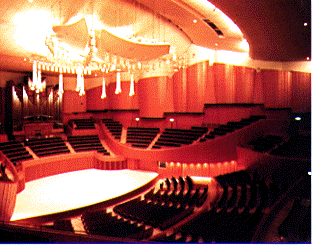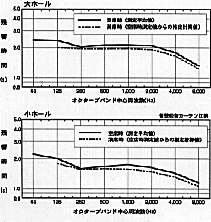
Title means "Quietness", "Comfortable Sound" and "Excellent Acoustics"
Nagata Acoustics News 97-7iNo.115j
Issued : July 25, 1997
Sapporo Concert Hall Opens
by Yasuhisa Toyota
2nd Floor Plan
 |
Main Hall
 |
Sapporo Concert Hall opened its doors for the first time on July 4, 1997. The new concert hall's opening festivities began with a concert by the Sapporo Symphony Orchestra under the baton of Maestro Kazuyoshi Akiyama. This was followed by the Pacific Music Festival's month-long series of concerts.
As the name of the hall indicates, Sapporo Concert Hall is located in the city of Sapporo, the largest city on Japan's northern island, Hokkaido. The new facility is comprised of a 2,008-seat large hall and a 453-seat small hall. Both halls were designed specifically for the performance of classical music. The city of Sapporo planned and commissioned the new facility. Hokkaido Engineering Consultants were the architects and Nagata Acoustics designed the acoustics.
Reverberation Time
 |
The large hall uses an arena configuration that surrounds the stage. The seating areas are divided into blocks in what has come to be known as the vineyard configuration. We drew inspiration from the Berlin Philharmonic Hall and Suntory Hall in Tokyo which both exemplify this hall shape.
Above the stage of Sapporo Concert Hall's large hall we installed a large sound reflection panel with an electrically powered height adjustment mechanism that enables the height of the panel to be adjusted at will.
Directly behind center stage, the large hall boasts a 68-stop pipe organ built by the French organ builder Alfred Kern. The large hall is excellently equipped to adapt to all kinds of classical music performances, focusing first and foremost on orchestral concerts.
Sapporo Concert Hall's small hall is a traditional shoebox-shaped hall. The balcony has a single row of seating on each side of the hall and several rows at the rear of the hall. Curtains that can be opened and closed were placed along the stage walls and the walls of the balcony to provide a low-tech means of adapting to the diverse needs of various instruments and ensembles. This hall will be used primarily for solo recitals and chamber music performances.
What distinguishes Sapporo Concert Hall from other recently completed halls in Japan is the early emphasis and concretization of performance content. Most halls initially focus on the facility and only worry about filling it with music and performances at a later stage of the project. In the case of Sapporo Concert Hall, the architectural and acoustical design planning took place with the benefit of considerable information on the performers and kinds of performances that will be held in the completed structure.
Sapporo is home to Hokkaido's preeminent orchestra, the Sapporo Symphony Orchestra. The SSO was founded in 1961 and has a roster of approximately 80 member musicians. The SSO keeps a busy schedule, with an 11-concert season-ticket series and numerous other concerts of popular classical favorites and special performances. The SSO's total number of annual performances in Sapporo averages around 50 each year. Thus, the SSO shoulders a large part of the responsibility for the city of Sapporo's vibrant classical music calendar. This has made local classical music lovers truly embrace its orchestra and, until the decision was made to build the new hall, also led to quite a din of complaints about the lack of a proper venue for the SSO's frequent performances.
In addition to the strong presence of the SSO, Sapporo is the annual venue for the Pacific Music Festival. The Pacific Music Festival was the brainchild of Leonard Bernstein. The festival's aim is to foster and train the next generation of classical music artists through participation in a month-long summer music festival. The first Pacific Music festival was held in 1990, making this year's festival the eighth annual Pacific Music Festival. In past years, performances were primarily held at the Geijutsu no Mori (Arts Forest), located in the suborbs of Sapporo. Each year, the entire funding for the Pacific Music Festival is underwritten by the city of Sapporo, including providing personnel to ensure the success of the festival. While many Japanese regional cities and towns now provide funding support for music festivals, the Pacific Music Festival leads the way in its scale and recognition in the world of music and musicians.
From the inception of Sapporo Concert Hall, its planners intended that the hall would be a new home for both the SSO and the Pacific Music Festival. This purpose is clearly written into the project's planning documentation and materials. The connection between the hall and both the SSO and the Pacific Music Festival is embodied in the new hall, where each of these music organizations has its own permanent office.
During the course of our acoustical design planning and during the construction period, we conferred frequently with the SSO, which we knew would be using the new hall on a regular basis throughout the year. In addition to incorporating the SSO's opinions and requirements into our acoustical design work, our frequent communication with the SSO enabled us to educate them and achieve their understanding about the acoustics of the new structure. In particular, the orchestra's seating arrangement and the setting of the height of risers built into the stage floor were certain to have a significant impact on the quality of the SSO's ensemble and the comfort level of the players. The SSO's preferred on-stage seating configuration would also have a significant influence on the new hall's perceived acoustical characteristics. During the construction phase of the new hall, we added a mock-up copy of the hall's raised stage to the existing rehearsal hall used by the SSO and we worked closely with the orchestra to fine tune the heights of the various rows to satisfy the SSO's artistic needs. We collaborated and expended much effort to help the orchestra understand the benefits of the staggered heights and become comfortable with this kind of seating arrangement. We worked so closely with the SSO on the system of stage risers, that it would not be an exaggeration to say that this aspect of Sapporo Concert Hall was custom designed specifically for the SSO.
Looking at the administration of the hall, now that it is completed, Sapporo Concert Hall mirrors many other publicly funded halls in Japan. The hall belongs to the city, and its administration is overseen by a foundation that exists for this purpose. Also like many other publicly funded Japanese halls, Sapporo Concert Hall will primarily be available to be rented by local organizations or promoters who will bring their own concerts and performances to the hall. Sapporo Concert Hall will also plan and promote concerts that will be interspersed with the events held on a rental basis. Of course, it is too early to forecast the extent or content of the concerts and programs that the hall will develop directly. The Opening Series of concerts planned to mark the hall's opening does not necessarily provide an accurate picture of what is to follow, so we must wait patiently to learn what performing opportunities the city of Sapporo will bring to its new facility.
However, what is fundamentally different from the situation of many other new halls in Japan, is that Sapporo Concert Hall has always had the SSO and Pacific Music Festival as assured tenants in this new musical home. The SSO, in particular, is a classical music presence that has no local or regional equal. Sapporo has nurtured both the SSO and the Pacific Music Festival to their present outstanding level, and it will be up to these two cultural assets of the city to fill the new hall with their presence. The Pacific Music Festival will be in residence for just one month a year each summer, so conflicts with individuals and organizations wishing to rent the hall may not be an issue. But as the SSO implements its year-long program in the new hall, scheduling conflicts will undoubtedly arise with promoters and others who rent the hall. It is easy to foresee that the new hall will repeatedly need to negotiate and handle scheduling conflicts, especially concerning the use of the hall for rehearsals.
Ideally, the relationship between an orchestra and the concert hall where it performs should be intimate and of supreme importance to the hall. In Europe and the United States, major concert halls each have their own resident orchestra, and the artistic benefit of this arrangement is clear from the reputations of both halls and orchestras that are closely tied and orchestras that do not have their own hall. The title "resident orchestra" thus has a more comprehensive meaning in Europe and the United States than it does in Japan. Until the opening of Sapporo Concert Hall, the resident orchestras of Japanese halls performed their regular season concerts in their specified hall, but they rehearsed elsewhere. In Europe and the United States, resident orchestras perform even their rehearsals in the same venue as the actual concert.
In many cities in Europe and the United States, one orchestra represents the classical music culture of the city and is the resident orchestra in a specific concert hall located in that city. Most of the concert halls that are constructed in European and U.S. cities begin as projects to provide a home for that city's orchestra. These halls are created and designed specifically for the orchestras that will reside in them. Sapporo is in the lucky position of being one of the few cities in Japan that is both large enough to contemplate a classical music concert hall and culturally sophisticated enough to have already nurtured an outstanding local orchestra to considerable prominence. Numerous other Japanese cities that have commissioned the construction of concert halls did not, unfortunately, already have a classical music cultural asset such as the SSO to fill their new halls with repeated classical music performances. As a result, the administrators of these halls are still searching for ways to fill their halls and bring purpose to their existence.
With the opening of Sapporo Concert Hall, we have high expectations for the future programming that will fill this hall. We do not expect this hall to be the constant venue of famous overseas orchestras on tour in Japan or other similar ostentatious classical music fare. Rather, we anticipate that the SSO will lead the way in developing programming and performances that will focus on local and regional artists and ensembles. Through these concerts Sapporo Concert Hall will truly implement and attain the purpose and goals that those who conceived it intended to achieve.
(For information about Sapporo Concert Hall, please call +81-11-520-2000; for the Sapporo Symphony Orchestra, call +81-11-520-1771; and for the Pacific Music Festival, call +81-11-520-2222.)
Nagata Acoustics News 97-7iNo.115j
Issued : July 25, 1997
Nagata Acoustics Inc.
E-mail: info@nagata.co.jp





